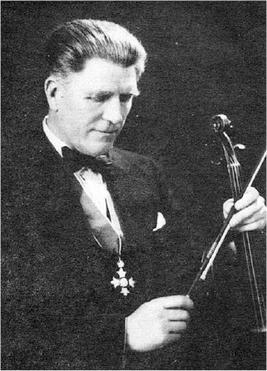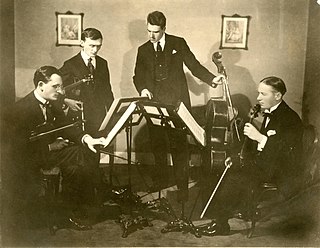Related Research Articles
Lillian Fuchs was an American violist, teacher and composer. She is considered to be among the finest instrumentalists of her time. She came from a musical family, and her brothers, Joseph Fuchs, a violinist, and Harry Fuchs, a cellist, performed with her on various recordings.
Karen Tuttle was an American viola teacher, most famous for developing the Karen Tuttle Coordination Technique, which emphasizes being comfortable while playing the instrument. She began performing on violin at the age of sixteen before switching to viola in 1941. Tuttle actively performed and taught at a number of institutions until her retirement in 2005.

Albert Edward Sammons CBE was an English violinist, composer and later violin teacher. Almost self-taught on the violin, he had a wide repertoire as both chamber musician and soloist, although his reputation rests mainly on his association with British composers, especially Elgar. He made a number of recordings over 40 years, many of which have been re-issued on CD.

The London String Quartet was a string quartet founded in London in 1908 which remained one of the leading English chamber groups into the 1930s, and made several well-known recordings.

The Amar Quartet, also known as the Amar-Hindemith Quartet, was a musical ensemble founded by the composer Paul Hindemith in 1921 in Germany. The quartet was active in both classical and modern repertoire until disbanding in 1933. It performed for many European concerts, broadcasts and recordings.
The New Hungarian Quartet was a string quartet founded by Andor Toth in 1972 at Oberlin Conservatory of Music, where members were on the faculty. It is separate from the well-known Hungarian Quartet, though the violist in both groups was the same. From 1975 until 1979 the quartet was the first faculty quartet-in-residence at the Taos School of Music in Taos, New Mexico.
The Stratton String Quartet was a British musical ensemble active during the 1930s and 1940s. They were specially associated with the performance of British music, of which they gave numerous premieres, and were a prominent feature in the wartime calendar of concerts at the National Gallery. After the War the group was re-founded as the Aeolian Quartet.

Arthur Catterall was an English concert violinist, orchestral leader and conductor, one of the best-known English classical violinists of the first half of the twentieth century.
Jean Pougnet was a Mauritian-born concert violinist and orchestra leader, of British nationality, who was highly regarded in both the lighter and more serious classical repertoire during the first half of the twentieth century. He was leader of the London Philharmonic Orchestra from 1942 to 1945.
Miguel del Águila is a prolific Uruguay-born American composer of contemporary classical music. He has been nominated three times for Grammys and has received numerous other awards.
Matthew Jones is a British violist, violinist and composer primarily known for his international performance work as a soloist, recitalist and chamber musician. He also holds a Viola Professorship and is Head of Chamber Music at Guildhall School of Music and Drama, and runs an in-demand performance health consultancy practice. He is fluent in Italian.

Marjorie Olive Hayward was an English violinist and violin teacher, prominent during the first few decades of the 20th century.

The Kutcher String Quartet was founded by its first violinist, Samuel Kutcher (1898-1984), who had by 1922 established himself as an accomplished solo artist and the previous year been a member of the Philharmonic String Quartet, playing second violin, along with Frederick Holding, E. Thomlinson (viola) and Giovanni Barbirolli (cello).
James Friskin was a Scottish-born pianist, composer and music teacher who relocated to the United States in 1914.

The Zorian Quartet was an English all-female string quartet ensemble. It was founded in 1942 by and named after violinist Olive Zorian. It gave the premiere performances of, and made the first recordings of, several compositions for string quartet by English composers, including Benjamin Britten and Michael Tippett. It also gave the premiere English performances of quartets by Ernest Bloch and Béla Bartók.

Olive Nevart Zorian was an English classical violinist.

Harry Waldo Warner was an English viola player and composer, one of the founding members of the London String Quartet and a several times Cobbett Competition winner for his chamber music.
Herbert Henry Kinsey (Kinze) was a British violinist and composer. Kinsey was a founder member and 2nd violinist of the English String Quartet in 1902, and a member of the famed London String Quartet from 1918. He played with the London Symphony Orchestra 1913–1928. His tutor books for the violin have been published by the Associated Board of the Royal Schools of Music since the 1930s.
Lena Wood,, was a British violist with the Birmingham Philharmonic String Orchestra and the Birmingham Ladies' String Quartet. She was a pupil of Lionel Tertis, performing and broadcasting with a number of ensembles from the 1920s to the 1950s.
Harry Berly was a British violist, saxophonist, clarinetist and violinist, who played with a number of British Dance Bands in the 1920s and 30s. He also appeared at the Proms and played with the International String Quartet.
References
- 1 2 British Library Sounds
- 1 2 Hindmarsh, Paul. 'Frank Bridge: seeds of discontent', in The Musical Times Vol. 132, No. 1775 (January 1991), pp. 695-698
- ↑ Huss, Fabian. The Music of Frank Bridge (2015), p.44
- ↑ Burn, Andrew. Notes to Naxos CD 8.557133
- ↑ Broadwood Concerts, 13 January, 1910. concertprogrammes.org
- ↑ Radio Times, Issue 699, 21 February 1937, p. 56
- ↑ 'Who's who in Music and Musicians' International Directory (1962), p. 142
- ↑ "Four Concerts". Bedfordshire Times and Independent. 1 October 1948.
- ↑ Front Matter, The Musical Times, Vol. 105, No. 1455 (May, 1964), p. 332
- ↑ 'English String Quartet', AllMusic
- ↑ Notes to Chandos CD 8392